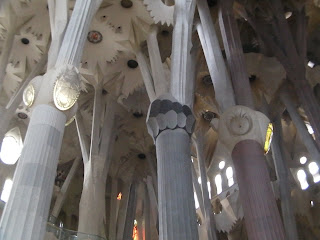I mentioned before that this magic square sums up to 33 in many different ways. So there are the usual horizontal, vertical and diagonal sums. But if you try (almost anything) you may just get 33, as long as you pick four numbers (and sana naman it's a nice pattern). For example, if you take the four corners, it sums up to 33. Also the four outer 2x2 squares. And the central 2x2 square. And a lot more.. But I leave the rest for the reader to prove.
Next up, the columns. I mentioned previously that there are different types of columns depending on the load that they have to bear. I also talked about how the number of sides depends on the type of column.
If you were observant in the last one, it seemed that the number of sides changes per individual column.
It actually does!

In order to be able to connect the column the the different parts of the cathedral, the columns would need to be circular at the top, despite being polygonal at the bases. That's why as you go up the column, the number of sides progressively doubles. From 12, to 24, to 36 and on and on. Eventually it will have enough sides to approximate an infinity-gon circle.

Continuous doubling of sides
more columns, merging with the ceiling.
Kinda looks like a tree right?
Here is the ceiling design for the Sagrada Familia:

The shape is not a cylinder from the roof down, but a hyperboloid. What is a hyperboloid? I hope I can still get this right... It's a three dimensional surface obtained by revolving a hyperbola around an axis.
From a cylinder...

But why? That's the question. Why bother filling the ceilings with hyperboloids? Is it just for aesthetics? Or is there another reason for doing so? While it is true that it does look nice, it has a practical reason too. Having a hyperboloid design actually improves the lighting of the basilica. Remember that light travels in a straight line. If the window opening were cylindrical, then light would only have one angle to enter, that is perpendicular to the window. With a hyperboloid shape though, light can enter through multiple angles of incidence, thus allowing more light to enter. It's a small change that makes a big difference.

It also improves acoustics! Since the sound waves are better dispersed by the shape!



No comments:
Post a Comment